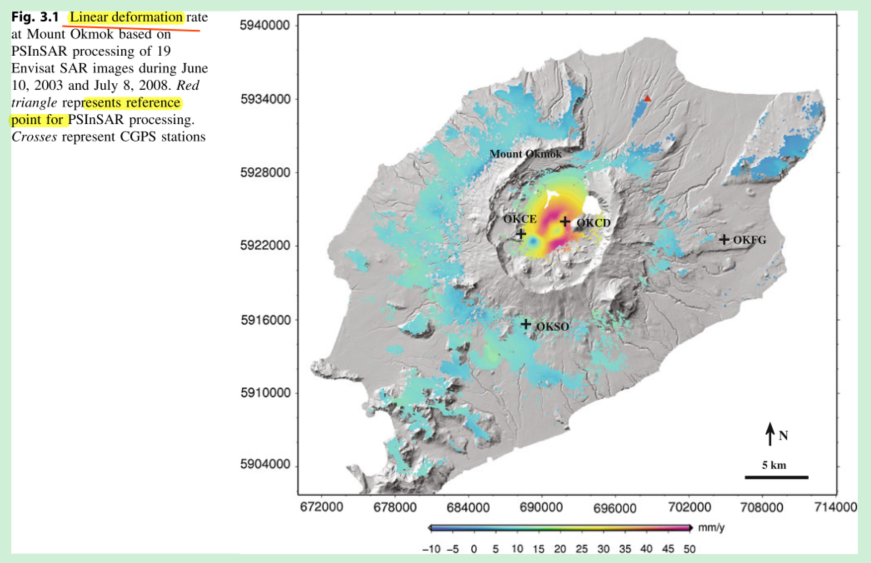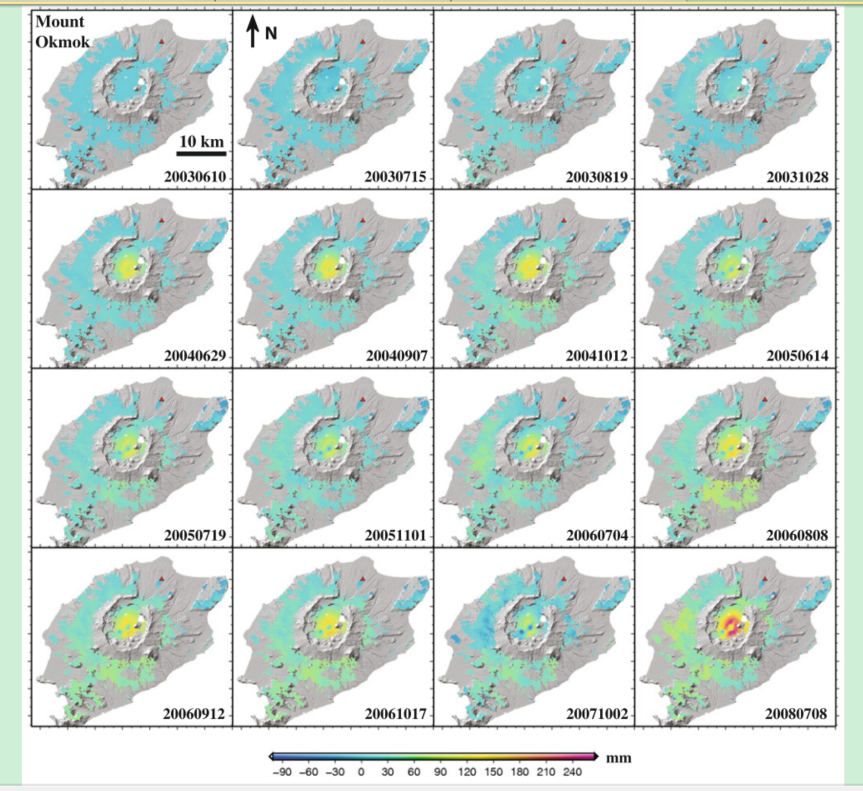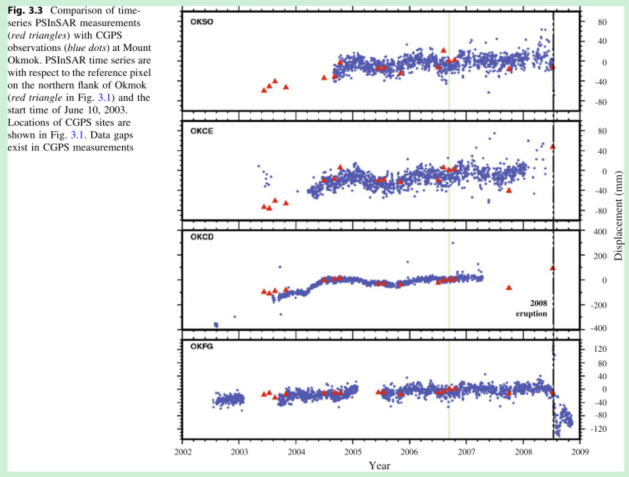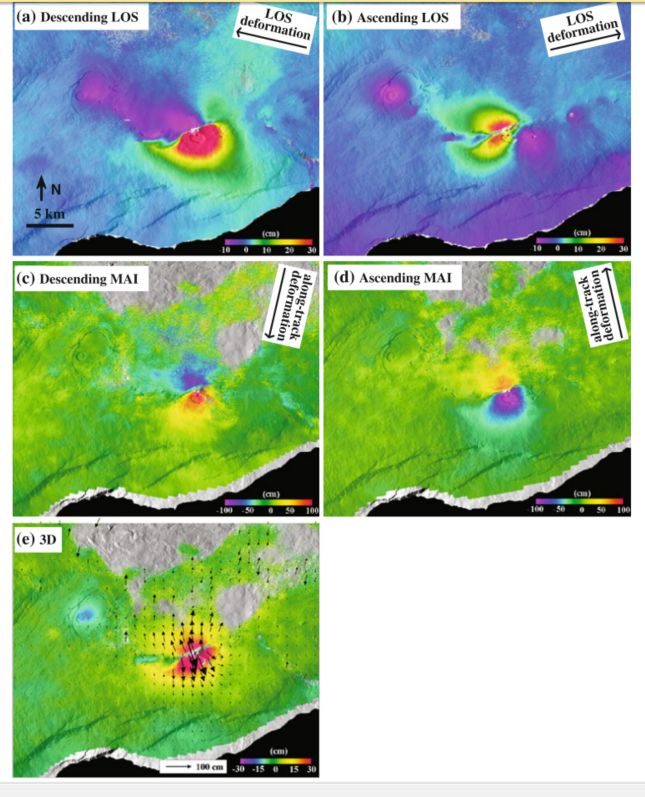本文将介绍几种常见的形变监测结果可视化方法,主要分为监测结果和误差可视化两种,监测结果又分为视线方向的监测结果和三维监测结果。
1 line-of-sight (LOS) direction 视线方向形变的可视化方式
1.1 Linear deformation rate 线性形变速度图
如下:

Linear deformation rate
其中红三角代表参考点,黑十字代表 continuous GPS (CGPS) station。该结果由19幅Envisat SAR影像通过PSInSAR处理得到,时间跨度为: June 10, 2003 and July 8, 2008.
可以想象这里的rate是通过形变总量除以总时间跨度得到的。
1.2 Deformation Time Series 形变时间序列图
如下:

Deformation Time Series
其中红三角代表参考点,这里我有一个困惑:每一个形变图都是相对于参考点的,那么每一幅图里面的参考点有没有变化呢?如果有,这个序列放在这儿有什么可比性呢?可能的解释是参考点相对火山口较远,可以认为不怎么形变。
1.3 PSInSAR监测结果和CGPS测量结果对比图
如下:

Comparison of timeseries PSInSAR measurements with CGPS observations
其中,红三角和蓝色的点分别代表CGPS和PSInSAR的结果,注意横轴表示的是时间,显然并不是所有时间两者都具有可比性。所以文中是这样分析的:
The time series are complementary and they match reasonably well where they overlap in time (i.e., mostly within one standard deviation in the CGPS measurements), which demonstrates that MTInSAR can be useful either as a stand-alone tool or in conjunction with other deformation monitoring techniques.
虽然文献里没有说,可以想象这里的CGPS测量结果是要规划到视线方向的。
2 三维形变的可视化方式
2.1 基于SAR影像进行三维形变监测的基本方法
Conventional InSAR techniques have demonstrated success in mapping surface displacements, but only in the radar line-of-sight (LOS) direction. Because SAR satellites occupy near-polar orbits (i.e., approximately N–S ground tracks and E–W look directions), it is impossible to measure small three-dimensional (3-D) surface displacements from LOS InSAR data alone, even when multiple independent interferograms with different viewing angles are used jointly.
However, when surface displacement magnitudes are on the order of meters, as is sometimes the case for large earthquakes, for example, it is possible to reconstruct the 3-D displacement field:
- using two interferograms (one ascending and one descending)
- one or two azimuth pixel offset tracking fields created by cross correlation of SAR images. This method depends on coherence of the image pairs and on the azimuth (along-track) pixel spacing of the SAR images. It can have low sensitivity to displacements in the along-track direction, depending on the pixel spacing.
- Multiple aperture interferometry (MAI) technique 是一种利用InSAR提高方位向位移测量精度的技术。 An MAI interferogram is created from forward- and backward-lookinginterferograms using sub-aperture InSAR processing. It hasbeen shown that the MAI technique has better sensitivity toalong-track displacements than the pixel offset tracking method(就是上面提到的基于SAR影像获取水平方向位移的技术手段).
2.2 三维形变可视化: 3-D displacement maps from MAI and LOS InSAR measurements
如下:

3-D displacement maps from MAI and LOS InSAR measurements
其中:
- a 降轨干涉图
- b 一段时间后的升轨干涉图
- c 对应a的降轨MAI干涉图
- d 对应b的升轨MAI干涉图
- e 三维位移场,其中箭头和颜色分别表示位移的水平和垂直成分。这个图是利用前四个结果得到的,至于怎么得到的,无非是矢量分解,后面再细说。
说明:从北往南降轨,反之升轨,注意其中的LOS方向
3 参考文献、图片来源
Hooper, A., Bekaert, D., Spaans, K., & Arıkan, M. (2012). Recent advances in SAR interferometry time series analysis for measuring crustal deformation. Tectonophysics, 514, 1-13.
Zhong, L., & Dzurisin, D. (2014). Insar imaging of aleutian volcanoes. Springer Praxis Books, 2014(8), 1778–1786.
Ketelaar, V. (2009). Satellite radar interferometry : subsidence monitoring techniques.
























 3255
3255

 被折叠的 条评论
为什么被折叠?
被折叠的 条评论
为什么被折叠?








